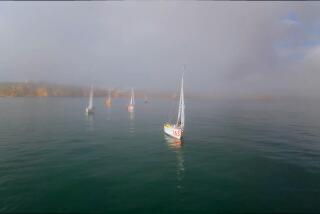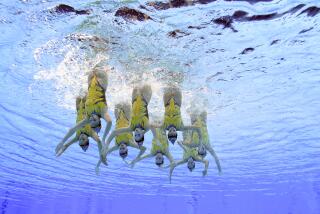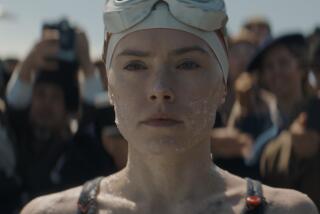Swimming the Strait : For Seven Hours, a Marathon Swimmer Faced Fear, Fog and Sharks in the Waters Between Africa and Europe. Then She Hit the Tough Part.
- Share via
For 10 years, marathon swimmer Lynne Cox of Los Alamitos had been planning a formidable project--to travel around the world in 80 days on a series of 12 long-distance swims that would include some of the world’s most challenging waters. Despite the complex problems of organization and bureaucracy, wrong flights, political unrest and trouble with customs, Cox finally achieved her goal in a hectic global tour that took her to Iceland, Italy, Greece, China, Japan and Alaska. This is an account of one leg of her journey, an 8 1/2-hour, 20-mile crossing of the Strait of Gibraltar.
I was halfway between Africa and Europe when the fog began closing in on our two boats, the Viuda 2 and a small Zodiac. Rory Wallbanks, our captain, radioed the Royal Navy and Air Force for a position fix, while Eric Shaw pulled his Zodiac beside me.
I had already been in the ocean for perhaps four hours, in unexpectedly cold 56-degree water, and now we were entering the shipping lanes, a water freeway that connects the Mediterranean Sea with the Atlantic Ocean. Wallbanks warned us to “watch for cross traffic.” But eerie gray tentacles of fog were wrapping tightly around us, consuming most of the Viuda 2 and part of the Zodiac right beside me. In this fog there was a chance that a ship would come within range and I would have to clear the water quickly.
Wallbanks had helped set up an elaborate ship-to-shore communication system to reduce potential problems. The navy was tracking us on radar, keeping us on course, updating our progress for the BBC and requesting other ships to give us a wide berth. Yet we knew that there were many vessels without radar out there, and in the fog we were invisible.
Suddenly, completely out of nowhere, a wave eight or nine feet high surged and suspended us in mid-air. “Turn left!” Wallbanks shouted. We expected a huge tanker to come crashing down on us out of the fog. Luckily, none emerged. But other ships were all around us, their horns bellowing warnings out of the mist--calling, echoing, rising and suddenly disappearing like phantoms in the night.
The swirling fog and unearthly calls unleashed some unwelcome memories: Years before, on a midnight swim across the Catalina Channel, I was separated from my escort and was lost in the fog for nearly an hour. The experience scared me out of my wits, and I broke off the swim, although on a clear night two weeks later I completed it.
Still, that fear of fog has persisted through the years. I tried to push it out of my mind, to concentrate on something else, but sometimes when I try to do that, I think of something even more frightening. I start to wonder about the sharks.
We had discussed using a shark cage, and there were two very different views: Joe Vitale, with the Gibraltar Bureau of Tourism, wanted me to use one. He said David Smith from San Francisco, the only person to swim from Morocco to Gibraltar, had used a cage. “At the end of the swim,” Vitale said, “when they pulled the cage out, it was full of dents and even man-sized holes.” A shark cage, though, is towed by a boat, and the cage creates drag that helps pull a swimmer along. To me that was cheating, like taking an elevator to the top of Mt. Everest.
Wallbanks agreed, but more important, he said that a cage was unnecessary, and he knew what he was talking about. For more than a decade he had been diving in Gibraltar’s waters. He had trained many Royal Navy divers, was in charge of many international dive competitions, and had led expeditions to the remains of sunken ships in the strait. He had dived with the local sharks and never had any close encounters.
As a precaution, though, Wallbanks and five crew members were in the lead boat, about 200 meters ahead, watching for large fins, while Shaw, an expert marksman, and another crew member were in the Zodiac. If a shark swam too close, they would push it away with a pole. If it began showing aggressive behavior, rearing back on its pectoral fins, it was time to climb out of the water and abort the swim. And if a shark suddenly came too close with its mouth agape, Shaw would use his rifle.
A gentle breeze began stirring the fog, peeling it away in sheets. Sunlight was pouring through the windows between clouds, while booted eagles, black terns, Egyptian vultures and osprey sailed above. Below, hundreds of squid swam soundlessly through the clear blue water, their bodies glistening as they passed through the beams of light.
We were three-fourths of the way across the strait. Even though I had been swimming for six hours and had covered nearly 17 miles, my arm strokes felt long, strong and fluid, as if I were skating with my arms across the glassy water, riding high in the buoyant Mediterranean, which tasted 10 times saltier than the Pacific. (I had to rinse my mouth with fresh water before I drank orange drink and ate a digestive cookie.) Under channel swimming rules, you aren’t allowed to touch the boat at any time during a swim, so you have to tread water while you eat. Sometimes if the water’s rough, your food gets pretty soggy, and you quickly learn what flavors mix well with saltwater. I was treading water by the Zodiac munching on my cookie when Wallbanks calmly warned us, “There’s a fin over there.”
A moment later Eric Shaw pointed, “Another one’s coming this way.” Everyone stood up, trying to determine whom the fins belonged to: If they swayed from side to side they were sharks; if they moved up and down they were dolphins. Finally, something black and white surfaced.
“Dolphins,” Wallbanks said.
You could hear them chattering excitedly and squeaking below. Soon nine or 10 dolphins were drawn to the melody of the Viuda 2’s motor, waltzing with the waves, gliding on the ship’s bow wave.
Now the sky was crystal- blue, and the towering white rock of Gibraltar filled the horizon. We were only two miles from shore, but this was where we faced the greatest obstacle: A strong countercurrent was building at the tip of the rock, as the tidal change grew stronger. It was racing at us at 2 1/2 knots, pushing us backward. It was like running a marathon and suddenly having the finish line moved backward an undetermined distance. “Can I have a cookie?” I asked, hoping for a break and a chance to replenish my energy. I had been swimming for seven hours, and all the travel, jet lag and fatigue was building up. My arms were tired and sore, and I wanted to finish. “No,” Wallbanks said. “Tide’s too strong. You’ve got to break through it before we can stop.”
I started sprinting, but we continued moving backward. It wasn’t much fun watching the rock get smaller and smaller. I was discouraged and hungry, and I was wondering if I was wasting energy. Maybe I would run out of strength before we reached the shore. Maybe we needed to change course, to use the westerly tidal push and aim for Spain, another 10 or 12 miles away. So I asked Wallbanks, and he said: “No, keep swimming. You’re doing brilliantly. The tide will turn soon.”
For encouragement, one of the crew members dived into the water and began swimming with me. He said people from Gibraltar had been following our progress on the radio, and one little girl just called and said: “Tell her she can make it. My mom and I are going to wait for her on the beach.” I swam faster and gained about half a yard in half an hour.
Then two dolphins appeared. They cruised 10 or 12 feet beneath me, then synchronously rolled on their sides to look at me with their blue-gray eyes. One of them let out a long squeak, and they swam off into the blue.
The dolphins were a good omen. Moments later the tide turned, and Wallbanks dropped a long-awaited oatmeal cookie into my hand. A smile spread across his face for the first time that day. “You’ve got less than a mile,” he said. “Go for it!” I put my head down for the last time and sprinted for shore.
More to Read
Sign up for Essential California
The most important California stories and recommendations in your inbox every morning.
You may occasionally receive promotional content from the Los Angeles Times.










